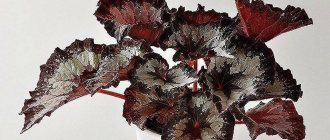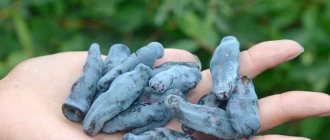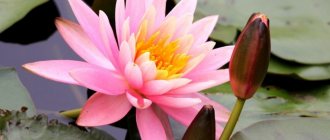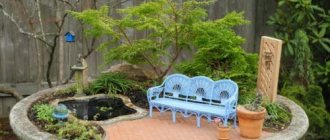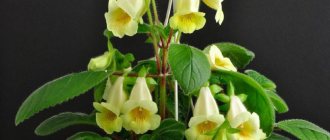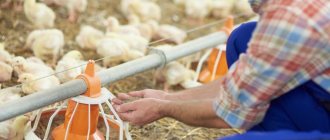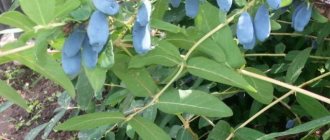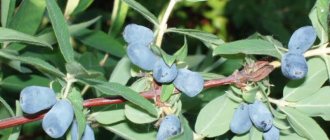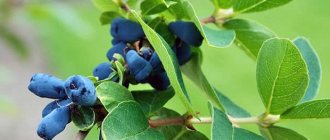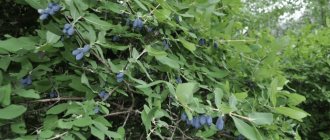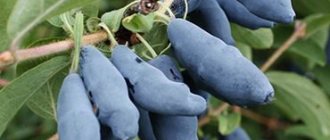Description of the plant
The plant is named for the shape of the tallest leaves, located just below the flowers - their bases are fused and form a green “plate”, which is “pierced” by the stem. In its natural state, this species is found in the Caucasus and the Middle East, and due to its relatively high frost resistance, it easily grows in our gardens.
The ornamental plant honeysuckle (Lonicera caprifolium), also called honeysuckle, belongs to the most popular representatives of this species. A showy climbing shrub with seasonal foliage that grows quickly and vigorously.
Morphology:
- Escapes . The bush has a fairly rapid growth rate (growth is about 1 meter per year), reaching a height of 3-4 meters. Its advantage lies in its low expansion - the plant wraps around the support, but does not produce root shoots, so it does not grow much to the sides. The branches (even young ones) are bare, which distinguishes them from other honeysuckles.
- Leaves. Green shiny leaves appear on thin, flexible shoots, growing in groups of 2 opposite each other. The leaves are broadly elliptical, with a short petiole, 4-10 cm long. The tallest leaves grow together to form a saucer hugging the stem (an important feature that distinguishes honeysuckle from other types of honeysuckle). On the underside, the leaf blades are bluish-greenish, bare.
- Flowers . The main decorative value of honeysuckle is its numerous flowers that develop at the turn of May – June. Flowers grow 1-2 per stem in the axils of the tallest leaves. Honeysuckle flowers are 4-5 cm long, often cream-colored, sometimes pink, and smell very pleasant. The Anna Fletcher variety blooms with yellow flowers, the more popular Inga produces creamy pink flowers with a pleasant vanilla aroma, especially intense in the evenings.
- Fruit. At the end of summer, the bushes produce fruits that ripen in September. Since September, the bush has been decorated with rounded orange fruits on a green “bowl” consisting of fused leaves, attracting birds to the garden. These fruits are not poisonous, but inedible - in large quantities they can cause stomach problems.
Photo. Honeysuckle honeysuckle fruit
Attention! Honeysuckle flowers are very toxic! They have a sweet taste, but contain toxic xylotein; ingestion of the flower can lead to severe poisoning and coma.
Honeysuckle-honeysuckle: cultivation
If you want to have an early flowering vine on your site, plant honeysuckle . If you have little time to care for your flower garden, but really want to have something reliable and unpretentious, plant honeysuckle honeysuckle . This is the same plant. The honeysuckle family is very large. But today we only focus on honeysuckles.
For the middle zone, this is simply an excellent candidate for the garden of a busy or elderly person. By planting honeysuckle near a gazebo or pergola, in just three years you can have an excellent shelter on a hot day, a beautiful frame for any building. Not only will there be greenery and flowers, but also the aroma. But honeysuckle has this aroma not only for us, but also for pollinating moths.
There is nothing random in nature. Butterflies have long proboscis, which they use to climb into tubular honeysuckle flowers. This will produce orange berries. You should not eat them, although they are not poisonous.
Honeysuckle blooms in May-June. At first, each flower blooms white, and then, as it ages, it turns creamy yellow. On one bush there are flowers of different shades, beauty! You can even prepare a small bouquet from honeysuckle and bring it home from the dacha. But it’s better to admire all the beautiful vines in the place where they grow.
Interesting varieties
- "Inga" - the variety grows up to 3 meters, the leaves are pubescent. The flowers are beige and fragrant. Flowering: May – June, orange fruits ripen from August to October.
- “Praecox” is an early variety, grows up to 5-15 m. The flowers are white-pink, tubular, collected in heads. Flowering: May-June. The foliage is fused. Prefers sunny and semi-shaded places.
- "Rubella" - flowers on the outside with a purple tint, a honey-bearing variety.
Planting in open ground
Honeysuckle is not difficult to plant and grow; it is important to choose a suitable place for it in the garden.
Landing site requirements
Honeysuckle will withstand winter frosts if provided with a quiet, warm position in the garden. The climbing vine of honeysuckle requires stable support, for example:
- mesh with large cells;
- alcove;
- pergola;
- grille attached to the wall.
If honeysuckle needs to be planted next to a wall, you need to choose a truly sunny wall - this plant blooms most profusely in full sun, although it can tolerate partial shade.
Honeysuckle does not like stagnant water and extremes such as very dry sandy or very heavy loamy soils.
In general, honeysuckle requirements for soil are quite modest:
- it grows well in any neutral or slightly alkaline soil;
- the soil needs to be sufficiently moist, but not wet;
- The high humus content in the soil promotes abundant flowering.
Attention! The soil near the wall is always dry, so honeysuckle planted in such a place requires increased watering.
Landing - step by step
In stores and garden centers, honeysuckle is usually available as container plants. Seedlings grown in containers can be planted throughout the growing season, but it is worth considering the planting zone and how quickly frosty days will arrive in the fall.
When to plant honeysuckle? Due to incomplete frost resistance, this type of honeysuckle should not be planted in open ground in the fall. The best time to plant honeysuckle honeysuckle is spring. Like other spring-planted shrubs, it will require plenty of water until established, but due to its spring planting date, there will be much less risk of it freezing in the winter.
It is better to plant honeysuckle on a cloudy day, preferably immediately after rain.
Landing progress:
- We dig a hole. If the bush is planted near a wall, dig a hole 25-50 cm from it. If we want to use honeysuckle to cover a fence, we plant the plants at intervals of about 1 meter.
- The soil should be carefully dug up and loosened; it is worth adding peat, well-rotted manure or compost to improve moisture holding capacity.
- Before planting the shrub, install supports on which the honeysuckle rises, so as not to damage the roots later.
- We place honeysuckle seedlings in the pits. We place them 5-10 cm deeper than they grew in pots.
- We compact the soil and water it.
- After compacting the soil and abundant watering, we tie the shoots to the support.
- It is worth covering the soil around the bush with bark to reduce water evaporation.
How to plant honeysuckle
In order for a bush to please the eye with its beauty, you need to know how to plant the plant correctly and choose a place for it.
Landing place
First of all, it is necessary to find an area protected from the wind, since the leaves suffer greatly from this negative natural factor, which reduces the decorative value of the plant. It is also best to choose a sunny location, although some varieties do well in partial shade or even under trees.
How to choose soil
There are also requirements for the soil. The crop prefers fertile soil and does not tolerate excessive acidification, so if necessary, the area should be sprinkled with lime to normalize acidity. A flowerbed with light, well-draining soil is ideal. Humidity should be average, without stagnation of water near the rhizomes.
The sprouts themselves can be bought on the market, but then the result will be unpredictable.
Where to get seedlings
I recommend purchasing seedlings either from specialized nurseries, or directly asking for cuttings from a bush you like from familiar gardeners, since small shoots of honeysuckle of different varieties are almost indistinguishable from each other.
Good young bushes should have a dense root system and flexible, not dry shoots without breaks or damage. But the presence of peeling on the bark should not be scary - this is such a feature of the plant.
By the way, if a crop is planted not only for beauty, but also for fruiting, then it is worth buying several varieties at once, as they are better pollinated and produce a larger harvest.
- It is better to plant sprouts in the fall, perhaps at the end of August. Only late varieties are allowed to be planted in spring due to early bud break;
- For good crop growth, it is recommended to dig holes about 40 cm wide and deep;
- When planting in a row (in the case of a green hedge) - 1.5 meters apart for low-growing varieties and about 2.5 for tall ones;
- 2 buckets of compost, 1 kilogram of ash and 50 grams are added to each hole. superphosphate;
- For sandy soils, you can add a little compost and a drop of potassium fertilizer;
- Next, the hole is watered and the seedling is immersed in it;
- Its roots are carefully crushed with soil to avoid the formation of air voids;
- Next, the hole is completely filled up and watered again. If desired, the roots can be immediately mulched with wood chips, grass, or sawdust.
Growing and care
Growing honeysuckle includes watering, fertilizing, pruning as desired, and controlling diseases and pests.
Trimming
The annual growth of honeysuckle is 0.5-2 meters, depending on soil fertility. If necessary, the shoots can be shortened, but this is not necessary to maintain the bush in good condition. The appearance of the vine is favorably affected by formation, which should be carried out during the first two years after planting:
- In the first year . In the spring of the first year, all honeysuckle shoots are shortened by 2/3 for good growth.
- In the second year . Next season, we select several skeletal shoots (no more than 4), the remaining ones are cut off close to the ground.
What to do if the lower parts of the trunks of honeysuckle are exposed? Old shrubs tend to bare shoots of leaves at the base and therefore require rejuvenation. This procedure is carried out once every 6 years - the oldest shoots are cut off near the soil surface. To avoid weakening the bush too much, you can spread the pruning over 2 years.
Fertilizer
Honeysuckle requires regular fertilization due to its rapid growth and abundant flowering and fruiting. Every spring you need to loosen the soil around the bush, mixing it with crushed compost or rotted manure. If there is no organic matter, the use of mineral fertilizers for flowering plants will bring good results. They usually come in the form of granules that are dispersed under the bushes twice:
- at the beginning of the growing season;
- at the turn of spring and summer (no later than the last ten days of June).
Watering
Regular watering plays an equally important role in caring for honeysuckle, which is especially necessary in the summer, when the fruits are forming and the weather is hot and dry. It is better to water the bushes less often, but abundantly, because only then does the water reach the deepest layers of the soil where the roots are located.
Wintering
Honeysuckle is quite resistant to frost. Planting and caring for honeysuckle in the Moscow region does not cause problems; there is no need to cover the bush for the winter; it tolerates the winters of central Russia well. Young plants need to be covered with agrofibre at the end of November.
However, it is better to plant the shrub on the sunny side, protected from strong northern winds. Reviews from some gardeners from the northern regions of the Moscow region indicate that it is better to cover honeysuckle growing without shelter from cold winds for the winter, for example, with a layer of lutrasil. Even if honeysuckle freezes, it quickly grows back, producing young shoots from the roots.
Diseases and pests
The most common problem in growing honeysuckle is powdery mildew. In mid-summer, a white coating can be observed on the leaves of honeysuckle, quickly covering an increasing area. This is a sign of powdery mildew disease. The disease must be combated using biological products or chemicals - fungicides, for example, Topsin. The Inga variety is more resistant to powdery mildew. The disease often appears on plants growing in partial shade where there is no air flow.
Honeysuckle may suffer from leaf spot. The following drugs are useful for the fight: Discus, Domark. It is better to repeat spraying 2-3 times at 10-day intervals, using different preparations.
Aphids are the most dangerous pest that attacks honeysuckle. If honeysuckle grows next to a sunny wall with a southern or eastern exposure, sooner or later it will become a habitat for aphids. You should start searching for pests in May - the earlier you detect uninvited guests, the easier it is to get rid of them. Aphids appear en masse in May on the tops of shoots. More often, aphids attack plants growing in dry and sunny places, flower buds and young leaves. They disfigure the bushes, causing deformation, inhibition of shoot growth, and significantly reduce flowering.
An effective method of combating aphids is spraying with undiluted nettle extract or infusion (200 g of dried nettle per 1 liter of water). In case of extensive pest damage, you can use garlic-based biological products or selective insecticides that do not harm beneficial insects. Use drugs Decis, Mospilan, Pirimor or others recommended against aphids.
Dangerous diseases and pests of decorative honeysuckle
With dry, warm summers, there is no danger for ornamental honeysuckle to get sick. But rainy, cold weather is dangerous for this plant.
Especially when the rains are prolonged. There is a risk of contracting peronosporosis, powdery mildew, and rust. A diseased plant becomes immediately noticeable:
the leaves are covered with a white coating and yellow-gray spots. Leaves are falling.
HONEYSUCKLE. All about growing honeysuckle - video
If young shrubs are overfed with nitrogen, this will lead to an increase in green mass. And here such insects appear - pests such as whiteflies, spider mites, aphids, and scale insects.
Larvae simply love the juice of young plants.
. They can be detected by their waste, which they leave on the surface of the leaves. After this, the fungus develops. The plant begins to grow slowly. It loses its decorative appearance and weakens.
Reproduction
Honeysuckle is propagated in 2 ways:
- lateral layers;
- cuttings.
By layering
The easiest way to propagate honeysuckle honeysuckle is to grow lateral layers. You can do this at the end of summer, in August or early September.
How to grow cuttings:
- On a two-year-old shoot, the bark is cut along its central part in the area that is then buried in the ground. Wound phytohormones stimulate root formation.
- Place the shoot in a shallow hole and cover it with garden soil mixed with peat.
- We attach the upper part of the layer to the vertical support.
- A new plant from the mother bush is cut off next spring or after 2 years, when it is well rooted.
Cuttings
A method that requires a little more work is propagation of honeysuckle honeysuckle by cuttings or rooting of shoots, which is carried out at home or in a greenhouse.
How to grow honeysuckle seedlings from cuttings:
- Shoots with leaves up to 10-15 cm are cut in June and July, preferably in the morning. The day before, the bush is watered abundantly.
- After cutting, the leaves are removed from them (except for the top pair).
- The shoots are immediately planted in a permeable substrate - for example, in a pot filled with peat, garden soil and sand, mixed in equal proportions.
- If the mother plant was watered thoroughly the previous evening, the cuttings should form roots quickly.
- It is worth covering them with film, which will limit the evaporation of water.
- To protect against fungal diseases, you need to avoid excessive thickening of young plants and ensure daily ventilation. Next year, if honeysuckle cuttings form strong roots, you can plant them in the ground.
Planting cuttings.
For honeysuckle honeysuckle, planting begins in early autumn. In a prepared place, holes are dug measuring 60x60x50 cm. The distance between neighboring bushes is maintained within one and a half meters. A specially created fertilizer (for 1 bucket) is added to each pit: peat manure compost; superphosphate - 50-80 g; potassium salt - 40-50 g. For planting in a permanent place, he uses cuttings that are 2 years old. The root collar of each seedling is positioned so that it rises 3.5-5 cm above the soil surface.
